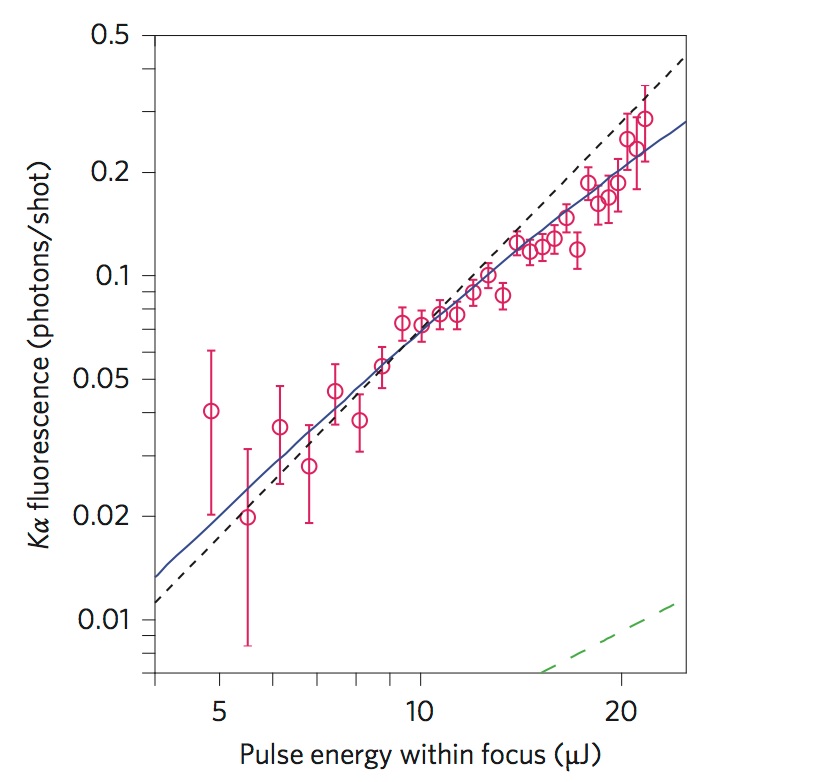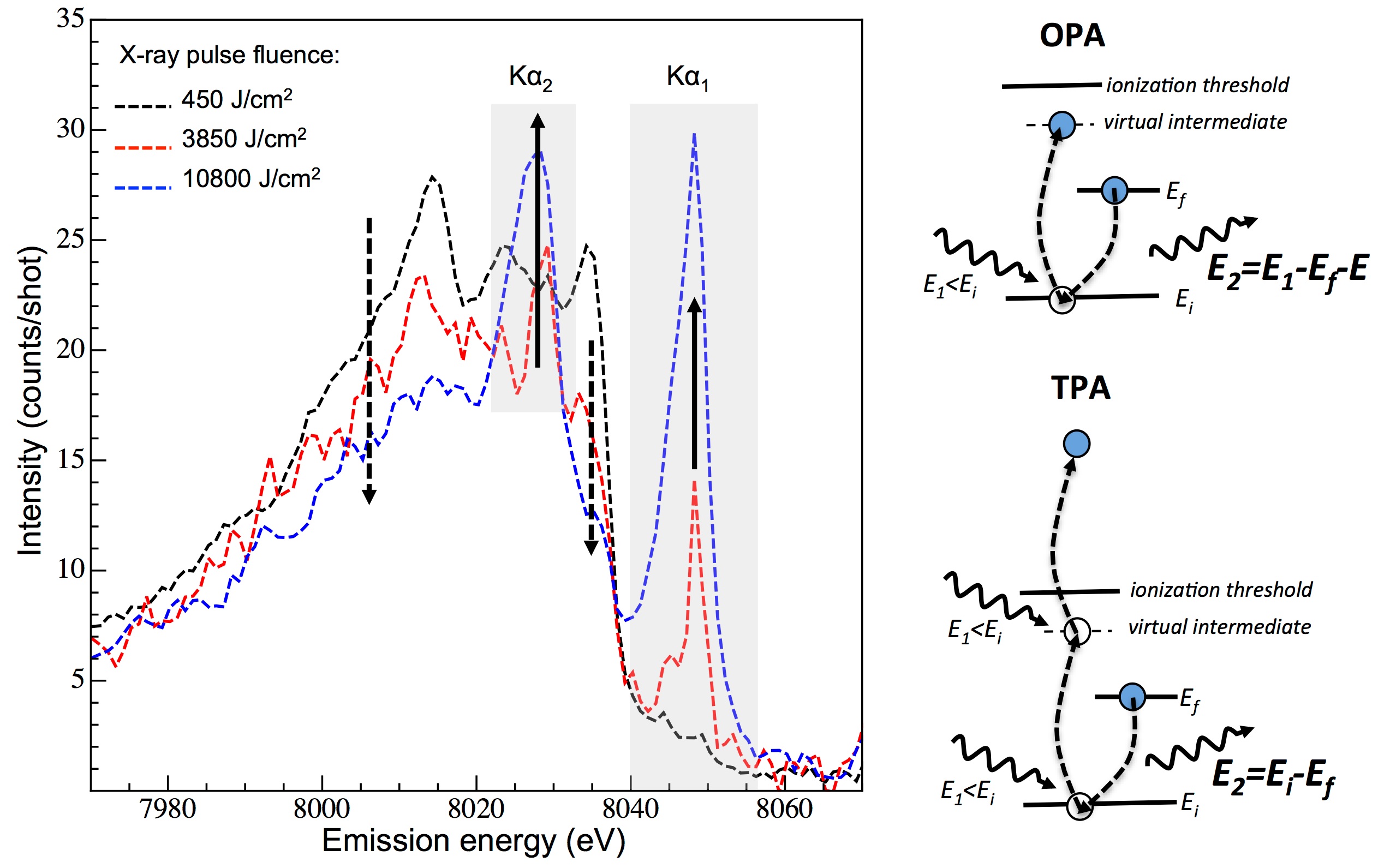Research project objectives
The recent development of X-ray free electron lasers (XFELs) allowed the field on nonlinear spectroscopy,
well explored at laser frequencies, to be extended into the Angstrom wavelength regime. In contrast to the
laser wavelengths, the photon-atom interaction at hard X-ray energies involves bound core-electrons and
leads to the intermediate electronic states with sub-femtosecond lifetimes. The femtosecond X-ray lasers
allow thus to access an uninvestigated area of physics and to probe the physical mechanisms that drives to
the nonlinear interaction of X-rays with matter. Among different possible paths of X-ray interaction with
matter in a nonlinear manner, the two-photon absorption (TPA) mechanism possesses attractive features,
which can be explored in application to X-ray spectroscopy at XFEL sources.


Figure 1: Pulse-energy dependence of Ka fluorescence resulting from twophoton absorption in solid germanium (open circles). The dashed line with a slope of 2 is compared to the solid line, which includes the effect of single and sequential multi-photon processes. Source
Figure 2: left) X-ray emission spectra recorded at energy of -12eV below K-ionization threshold of Cu for different incident X-ray fluence. The directions of spectral changes are marked by black-dashed (for HEROS part) and black arrows (for Ka emission), respectively. right) Schematic representation of OPA and TPA processes at off-resonant regime (E1 < Ei). While for OPA process the emitted X-ray energy (E2) relates directly to incoming X-ray energy (E1), the TPA mechanism leads to an ionization event and therefore emitted X-ray energy is constant and equal to energy difference between initial (Ei) and final (Ef) electronic states.
The TPA process, theoretically predicted in 1931 and experimentally confirmed in 1960’, is nowadays commonly used as a spectroscopic tool in diverse areas of science. However, in the hard X-ray regime the TPA process in condensed matter has been observed for the first time only recently thanks to tremendous development of XFEL sources (K. Tamasaku et al., Nature Photon. 313, (2014)). In application at hard X-ray energies, the TPA mechanism will allow accessing different excitation states of matter thanks to the selection rules that drives the electronic TPA transitions. Comparing to one-photon absorption (OPA) excitations which are determined by dipoleallowed transitions, the TPA process requests changing the electron angular momentum by +/-2 or 0, allowing thus to access a quadrupole or forbidden excitations. This may lead to creation of new and unexplored states of matter. However to this point, the studies of TPA was still questionable because of low cross-sections and unknown mechanisms driving the TPA process in hard X-ray regime. The proposed project aims at a combination of X-ray spectroscopy and theory to establish general rules for TPA mechanisms in the hard X-ray regime. Preliminary analysis of our XFEL experimental data reveals that the OPA off-resonant scattering may be regarded as the first step to the TPA process. This observation leads directly into unique finding: the TPA cross sections will be strongly dependent on the excitation energy following strictly the cross section-dependence of OPA at off-resonant excitations. To successfully confirm and evaluate this result a number of synchrotron- and XFEL experiments will be performed through the secured beamtime slots (SLS, and SwissFEL, Switzerland).
Research project methodology:
The project relies on application of high energy resolution X-ray emission spectroscopy to synchrotron- and XFEL- experiments. Within the project, we will determine the cross sections for off-resonant scattering (OPA regime) and TPA mechanism in the vicinity of an absorption edge. For the OPA regime, we intend to determine the off-resonant cross-sections for various materials at different excitation energies tuned to below an absorption edge for the element of interest. The experimental values will be examined with theoretical approaches based on differential cross-section formulas. As a result we intend to derive general scaling laws for off-resonant excitations, as a function of excitation energies as well as a function of the sample element. The extracted OPA cross-sections will be then used to determine the TPA yields. The relationships between OPA and TPA processes will be examined and, where possible, the correlations will be established. Within the project we will provide the X-ray fluence thresholds as a function of incident Xray energy for the TPA mechanism. This result will be very important for future XFEL spectroscopy studies, since it will deliver detailed information about X-ray fluence thresholds for which the TPA mechanism become dominant. Moreover, thanks to available high X-ray fluence at XFELs, we intend to disentangle two possible paths of TPA mechanism: sequential and simultaneous ionization. While at low X-ray fluence the sequential TPA dominates, the higher X-ray fluence may allow for detection of simultaneous two-photon absorption.
Expected impact of the research project on the development of science, civilization
and society
The results of the detailed studies of TPA process induced by hard x-rays from XFEL are of great fundamental interest for understanding the nonlinear quantum optics processes in hard xray energy regime. In particular, studies of the nature of TPA process by establishing the relationship between cross sections for TPA and OPA will allow to verify experimentally quantum description of interaction of X-ray radiation with bound-electrons in non-linear regime. In the future the TPA process may also allow for novel spectroscopic approaches to study the electronic structure of matter using intense, ultrafast, femtosecond pulses of x-rays delivered by XFELs.
